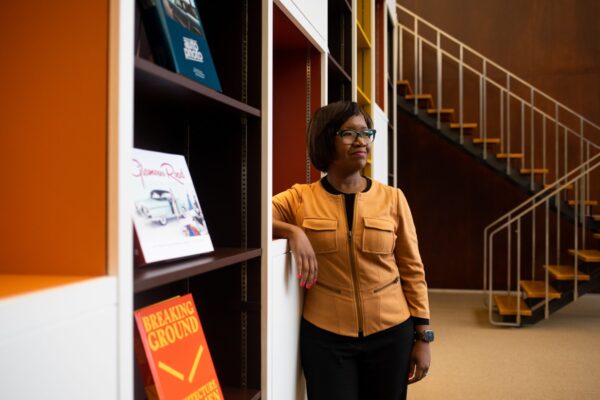By Robb Mandelbaum
In almost 30 years at General Motors Co., Crystal Windham has left her mark on the cars Americans drive—and on the auto industry itself. In 2008, she made GM history as the first Black woman appointed to serve as a design director. Today, as the automaker’s global executive director of industrial design, Windham has the final say on the colors, materials, finishes, interior hardware, and more for every GM vehicle.

Windham started at the company as an intern while studying industrial design at the College for Creative Studies in Detroit and was hired after earning her undergraduate degree in 1994. Two years later, spurred on by her mom, she enrolled at University of Detroit Mercy’s College of Business Administration. She attended night school off and on over the next seven years before graduating in 2003. She did much of her homework at the office—giving her a deeper understanding of what she was studying.
Here, Windham talks about how her business school studies shaped her career. Five years after graduating, the young designer was tapped to oversee all Chevrolet interiors. In 2016, Windham moved to Cadillac, leading the team that developed the interior for the luxury line’s first electric vehicle, the Lyriq. Today she manages projects that include a moon rover GM is developing with Lockheed Martin Corp. The interview has been condensed and edited for clarity.
Did any colleague in the design group at GM also have an MBA, or was that unusual?Unusual. Part of being competitive is putting yourself in a situation where you’re out of your comfort zone. Pursuing an MBA did just that for me. It could help me stand out if I wanted the opportunity to lead a group.
Was there anything in particular that you hoped to study?Having the opportunity to learn more about business ethics was extremely important. I feel like the university was ahead of the curve on the importance of that. Now they have an entire master’s of science in ethical leadership. It’s a great program that incorporates both diversity and sustainability.

Which class stood out to you as being especially meaningful?A favorite was a course on entrepreneurship and how to start your own business. At the time, real estate was a big, big thing. Having a second and third home and renting out homes. I was thinking how to set something like that up. But how to start your own business, what it takes to really frame it up, and who you want to have on your team—all of those elements of entrepreneurship can be applied to “intrapreneurship” if you’re working within a company.
Did your trajectory at GM change?I went from being the supporting designer to a lead designer. Then I had the opportunity the year that I graduated to lead a larger team as an interior manager. As I moved up, putting into practice those skill sets—organizational behavior and development, building effective teams—helped me become an effective leader. Then, after about 10 years of being on interiors, I started learning more about the foundation of exterior, which led me to be a design manager on exteriors for a project with China. To have a stretch assignment is pretty exciting, because they see something in you that can help the organization differently in another area.
Did University of Detroit Mercy help you overcome obstacles that a Black woman might face in an industry traditionally dominated by White men?What helped me tremendously was having examples before me. When you see someone like you, it helps you believe that it is possible. I was fortunate that in my internship, I was connected with a Black female designer here at General Motors, Marietta Ellis, and she became my first mentor. Being able to ask her questions—to watch her and how she navigates—was very beneficial.
Can business schools do better in enrolling people who’ve historically been excluded from the business world, and then help them navigate that world once they graduate?It starts with an individual like myself, knowing that I was in this unique situation—what am I doing to make sure that I’m not the first and only? I’m on the advisory board of the business school. Second, I help fund a scholarship for those that are minorities in this space. The next is mentorship: while you’re still getting your degree and then, of course, after you’re hired. We have a really detailed mentorship program for General Motors employees with African ancestry that I’ve been a part of for many years. When you have been identified as that unique individual, make sure that you’re reaching back and being part of the solution.Read more: Best Business Schools & MBA Programs 2022–23
More stories like this are available on bloomberg.com.




